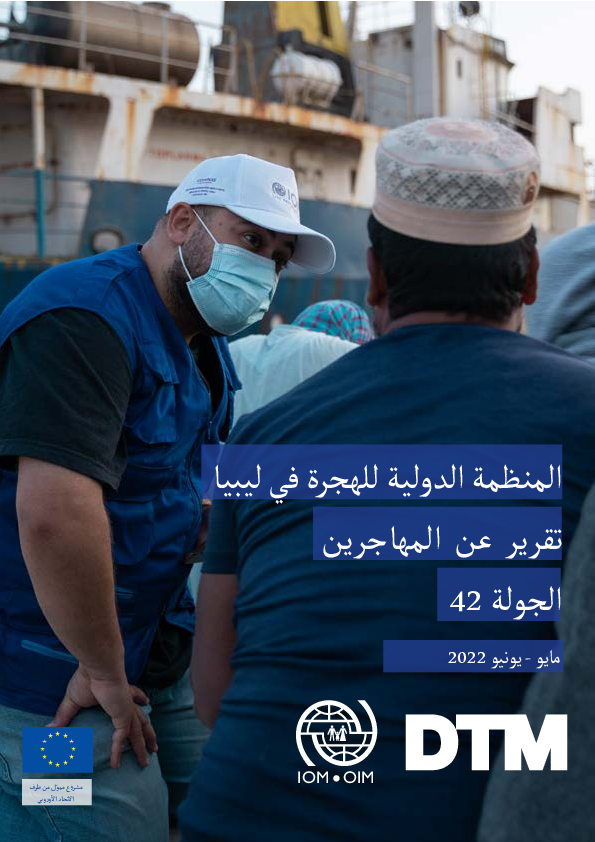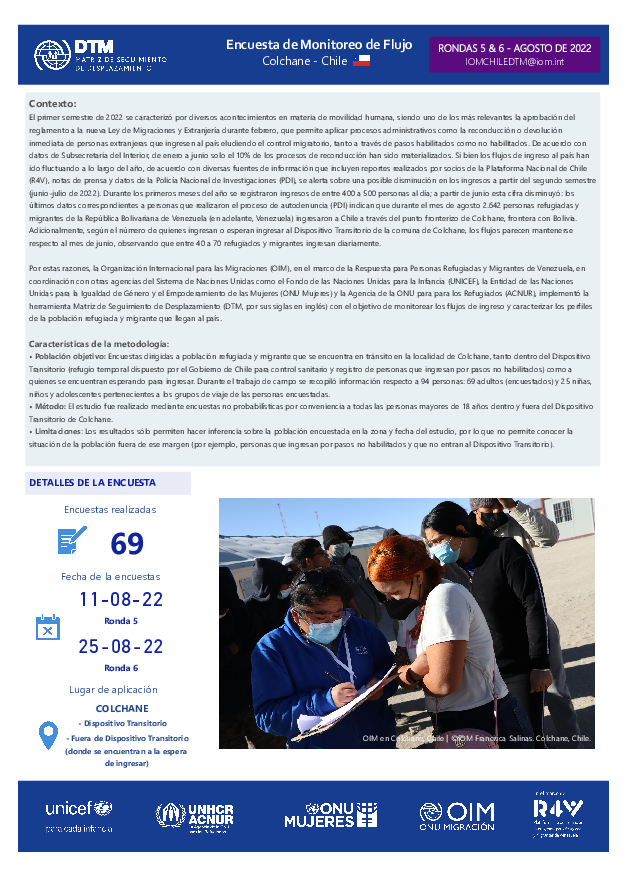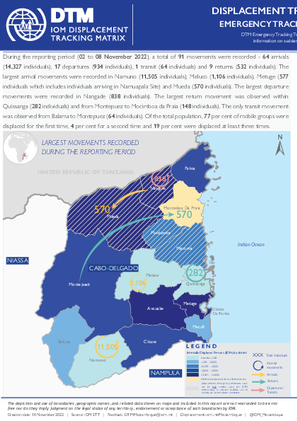-
Countries
-
Data and Analysis
-
Special Focus
-
Crisis Responses

Contact
DTM Libya, DTMLibya@iom.int
Language
Arabic
Location
Libya
Period Covered
May 01 2022
Jun 30 2022
Activity
- Mobility Tracking
- Baseline Assessment
في إطار الجولة 42 من تجميع البيانات (مايو – يونيو 2022)، أحصى مشروع مصفوفة تتبع النزوح في ليبيا الخاص بالمنظمة الدولية للهجرة وجود مجموع 667.440 مهاجرا في بلديات ليبيا الـ100 ينحدر أصلهم من أكثر من 41 جنسية.
ولازالت البيانات التي تجمعها مصفوفة تتبع النزوح في ليبيا تبرز أنّ عدد المهاجرين في ارتفاع مستمرّ في مقارنة بالجولة السابقة (649.788 مهاجر في الجولة 41، أبريل 2022) على منوال النّسق الذي بدأ في مطلع سنة 2021. ويتماشى هذا النسق أيضا مع وصول العمّال المهاجرين الموسميين إلى ليبيا (فيما بين شهري مارس ومايو عامّة).
ويفوق عدد المهاجرين الذين تم إحصاؤهم في ليبيا خلال الجولة 42 عدد المهاجرين لنفس الفترة من السنة الماضية (597.611 مهاجر، الجولة 37، يونيو 2021) وهو كذلك أعلى قليلا من عدد المهاجرين المسجّل في سنة 2019 (655.144 مهاجر، الجولة 26، يوليو 2019).

Contact
DTMUkraine@iom.int
Language
English
Location
Ukraine
Period Covered
Oct 17 2022
Oct 27 2022
Activity
- Survey
Starting on 24 February 2022, a large-scale armed conflict in Ukraine triggered an unprecedented humanitarian crisis across the country, characterised, among other elements, by the displacement of a significant proportion of the Ukrainian population.
As early as April 2022, the International Organization for Migration (IOM) began observing significant return movements. Conditions of return vary widely, as returnees arrive back to areas not directly affected by the war, but which have experienced a significant influx of internally displaced persons (IDPs), as well as to conflict-affected and recently de-occupied areas which have sustained severe damage. Due to the volatility of the current situation, it is impossible to determine what proportion of the returns observed at present are permanent or temporary. Existing data shows, however, that the returnee population in Ukraine is characterized by a unique set of needs and vulnerabilities which set it apart from those who had never been displaced and from the population of IDPs.
To support partners in providing targeted, evidence-based assistance to those returning to their areas of habitual residence following a period of forced displacement, IOM presents the Ukraine Returns Report. This publication will strive to analyze IOM’s latest data on the situation and needs of the returnee population and on the conditions of return, collected through the Displacement Tracking Matrix (DTM) assessments conducted in the country.
This October 2022 edition of the Ukraine Returns Report presents a detailed analysis of data collected through the ninth round of IOM’s General Population Survey (GPS), conducted between 17 and 27 October among the adult population in Ukraine. The geographical scope of the assessment covers the entire territory of Ukraine, all five macro-regions (West, East, North, Centre, South, and the city of Kyiv), with the exception of the Crimean peninsula and the non-government-controlled-areas of Ukraine (NGCA). The general population survey was conducted using a random‐digit‐dial (RDD) approach, and 2,002 unique and anonymous respondents aged 18 and over were interviewed using the computer-assisted telephone interview (CATI) method.

Contact
DTM Yemen, iomyemendtm@iom.int
Language
English
Location
Yemen
Period Covered
Nov 06 2022
Nov 12 2022
Activity
- Mobility Tracking
IOM Yemen DTM’s Rapid Displacement Tracking (RDT) tool collects data on estimated numbers of households forced to flee on a daily basis from their locations of origin or displacement, allowing for regular reporting of new displacements in terms of estimated numbers, geography, and needs. It also tracks returnees who returned to their location of origin.
From 1 January to 12 November 2022, IOM Yemen DTM tracked 9,349 households (HH) (56,094 Individuals) who experienced displacement at least once.
Between 6 and 12 November 2022, IOM Yemen DTM tracked 43 households (258 individuals) displaced at least once. The majority of people moved into/within the following governorates and districts:
- Lahj (18 HHs) – Al Qubaytah (14 HHs), Tuban (4 HHs) districts. Most displacements in the governorate were internal.
- Marib (13 HHs) – Marib (13 HHs) district. Most displacements in the governorate originated from Ibb and Dhamar.
- Al Maharah (7 HHs) – Al Ghaydhah (7 HHs) district. Most displacements in the governorate originated from Taiz and Al Jawf.
The majority of people moved from the following governorates and districts:
- Lahj (16 HHs) – Al Qubaytah (14 HHs), Al Musaymir (2 HHs) districts.
- Taiz (8 HHs) – Maqbanah (3 HHs), Sharab Ar Rawnah (2 HHs), Jabal Habashi (1 HH) districts.
- Al Hodeidah (5 HHs) – Bajil (2 HH), Al Hawak (1 HH), Al Jarrahi (1 HH) districts.
Contact
DTM Yemen, iomyemendtm@iom.int
Location
Yemen
Activity
- Mobility Tracking
- Event Tracking
Period Covered
Nov 06 2022 -Nov 12 2022
From 1 January to 12 November 2022, IOM Yemen DTM tracked 9,349 households (HH) (56,094 Individuals) who experienced displacement at least once.
Between 6 and 12 November 2022, IOM Yemen DTM tracked 43 households (258 individuals) displaced at least once. The majority of people moved into/within the following governorates and districts:
- Lahj (18 HHs) – Al Qubaytah (14 HHs), Tuban (4 HHs) districts. Most displacements in the governorate were internal.
- Marib (13 HHs) – Marib (13 HHs) district. Most displacements in the governorate originated from Ibb and Dhamar.
- Al Maharah (7 HHs) – Al Ghaydhah (7 HHs) district. Most displacements in the governorate originated from Taiz and Al Jawf.
- Lahj (16 HHs) – Al Qubaytah (14 HHs), Al Musaymir (2 HHs) districts.
- Taiz (8 HHs) – Maqbanah (3 HHs), Sharab Ar Rawnah (2 HHs), Jabal Habashi (1 HH) districts.
- Al Hodeidah (5 HHs) – Bajil (2 HH), Al Hawak (1 HH), Al Jarrahi (1 HH) districts.
Population Groups
Survey Methodology
Unit of Analysis Or Observation
Type of Survey or Assessment
Keywords
Geographical Scope
Administrative boundaries with available data
The current dataset covers the following administrative boundaries
Contact
DTM Burundi, DTMBurundi@iom.int
Location
Burundi
Activity
- Mobility Tracking
- Event Tracking
Period Covered
Nov 07 2022 -Nov 13 2022
Entre le 7 et le 13 novembre 2022, la DTM a identifié 88 personnes affectées, dont 70 personnes déplacées, par des pluies torrentielles et vents violents dans les provinces de Ruyigi, Bururi et Makamba.
Population Groups
Survey Methodology
Unit of Analysis Or Observation
Type of Survey or Assessment
Keywords
Geographical Scope
Administrative boundaries with available data
The current dataset covers the following administrative boundaries

Contact
iomdtmchile@iom.int
Language
Spanish
Location
Chile
Period Covered
Aug 11 2022
Aug 25 2022
Activity
- Survey
- Flow Monitoring
El primer semestre de 2022 se caracterizó por diversos acontecimientos en materia de movilidad humana, siendo uno de los más relevantes la aprobación del reglamento a la nueva Ley de Migraciones y Extranjería durante febrero, que permite aplicar procesos administrativos como la reconducción o devolución inmediata de personas extranjeras que ingresen al país eludiendo el control migratorio, tanto a través de pasos habilitados como no habilitados. De acuerdo con datos de Subsecretaria del Interior, de enero a junio solo el 10% de los procesos de reconducción han sido materializados. Si bien los flujos de ingreso al país han ido fluctuando a lo largo del año, de acuerdo con diversas fuentes de información que incluyen reportes realizados por socios de la Plataforma Nacional de Chile (R4V), notas de prensa y datos de la Policía Nacional de Investigaciones (PDI), se alerta sobre una posible disminución en los ingresos a partir del segundo semestre (junio-julio de 2022). Durante los primeros meses del año se registraron ingresos de entre 400 a 500 personas al día; a partir de junio esta cifra disminuyó: los últimos datos correspondientes a personas que realizaron el proceso de autodenuncia (PDI) indican que durante el mes de agosto 2.642 personas refugiadas y migrantes de la República Bolivariana de Venezuela (en adelante, Venezuela) ingresaron a Chile a través del punto fronterizo de Colchane, frontera con Bolivia. Adicionalmente, según el número de quienes ingresan o esperan ingresar al Dispositivo Transitorio de la comuna de Colchane, los flujos parecen mantenerse respecto al mes de junio, observando que entre 40 a 70 refugiados y migrantes ingresan diariamente

Contact
DTM Burundi, DTMBurundi@iom.int
Language
English
Location
Burundi
Period Covered
Nov 07 2022
Nov 13 2022
Activity
- Mobility Tracking
- Event Tracking
Entre le 7 et le 13 novembre 2022, la DTM a identifié 88 personnes affectées, dont 70 personnes déplacées, par des pluies torrentielles et vents violents dans les provinces de Ruyigi, Bururi et Makamba.

Contact
DTM Nigeria, AllUsersInDTMNigeria@iom.int
Language
English
Location
Nigeria
Period Covered
Oct 01 2022
Oct 31 2022
Activity
- Event Tracking
Early Warning System of Transhumance Tracking Tool (TTT) as a component of the IOM's Displacement Tracking Matrix (DTM) aided by community Key Informants record through the focal person, related alerts to transhumance activities. This report presents TTT Early Warning alerts collected in five LGAs of Adamawa State (Demsa, Girei, Lamurde, Numan and Mayo-Belwa) for October 2022.
214 alerts were recorded for the period under review, including 203 events and 11 movement alerts that represent 95 and 5 per cent of alerts, respectively. Lamurde LGA recorded the highest number of alerts at 26 per cent, followed by Demsa LGA at 25 per cent, while Mayo-Belwa, Girei and Numan LGAs recorded 21, 19 and 9 per cent respectively. Of the disaggregated data in October 2022, the Ndikong ward in May-Belwa LGA recorded the highest numbers at 9 per cent of the total event alerts, followed by Nassarawo Demsa in Demsa LGA at 7 per cent. Events alerts include farmers-herders conflict, farm destruction, cattle rustling/livestock theft, kidnappings, robberies, accidents, violent attacks, intra-and inter-community tensions as well as disasters due to natural hazards.
Some of the potential conflict-prone risk areas identified for the month under review are Demsa, Girei, Mayo-Belwa and Shelleng LGAs. Transhumance movements and the TTT early warning platform supported the identification of these potential conflict-prone risk areas.

Contact
DTM DRC, iomdrcdtm@iom.int
Language
French
Location
Democratic Republic of the Congo
Period Covered
Oct 20 2022
Nov 12 2022
Activity
- Mobility Tracking
- Event Tracking
Depuis novembre 2021, les attaques de l’ex-groupe rebelle M23 ont repris et se sont multipliées contre les forces armées congolaises (FARDC) dans l’Est de la RDC. Ces affrontements se sont encore intensifiés depuis mars 2022, à la faveur desquels le M23 s'est emparé en juin 2022 de la ville de Bunagana, située à la frontière avec l'Ouganda, ainsi que d'autres localités voisines dans les régions de Jomba, Bweza, Kisigari et Busanza, en territoire de Rutshuru. Fin octobre 2022, les anciens rebelles du M23 ont étendu leur emprise après plusieurs offensives, élargissant leur contrôle sur l'ensemble de la chefferie de Bwisha, y compris la capitale du territoire et la ville de Kiwanja, avec des plans présumés d'extension sur l'ensemble du territoire. Dans le territoire de Rutshuru, ces attaques ont déplacé 234 488 personnes (40 027 ménages) depuis les zones de combat (groupements de Jomba, Bweza et Kisigari) vers des zones considérées comme sécurisées dans les territoires de Nyiragongo, Rutshuru et Lubero, notamment les zones de santé de Nyiragongo, Bambo, Kayna et Kibirizi.

Contact
DTMMozambique@iom.int
Language
English
Location
Mozambique
Period Covered
Nov 02 2022
Nov 08 2022
Activity
- Mobility Tracking
- Event Tracking
During the reporting period (02 to 08 November 2022), a total of 91 movements were recorded - 64 arrivals (14,327 individuals), 17 departures (934 individuals), 1 transit (64 individuals) and 9 returns (532 individuals). The largest arrival movements were recorded in Namuno (11,505 individuals), Meluco (1,106 individuals), Metuge (577 individuals which includes individuals arriving in Namuapala Site) and Mueda (570 individuals). The largest departure movements were recorded in Nangade (838 individuals). The largest return movement was observed within Quissanga (282 individuals) and from Montepuez to Mocimboa da Praia (148 individuals). The only transit movement was observed from Balama to Montepuez (64 individuals). Of the total population, 77 per cent of mobile groups were displaced for the first time, 4 per cent for a second time and 19 per cent were displaced at least three times.